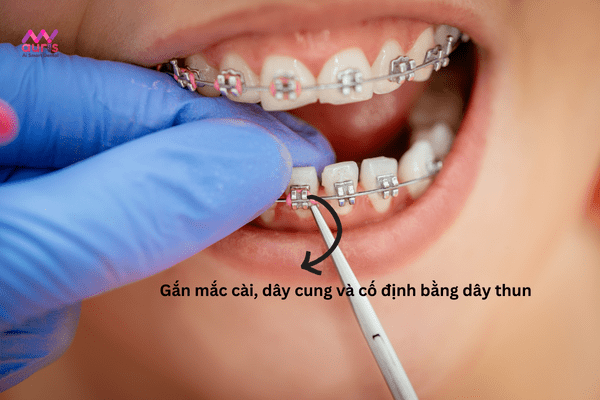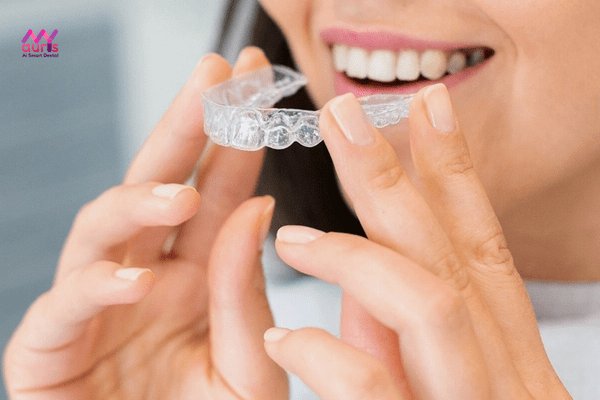Sparse teeth are a condition in which teeth grow apart, without close alignment. This condition is not only unsightly but also hinders oral function and chewing ability. Braces are the perfect solution to overcome this situation, helping to eliminate the gap between teeth. However, before achieving the expected results, everyone will have to go through the steps in the braces process. Follow this article with My Auris dentistry.
Why should you get spaced braces?
Spreaded teeth are an option that many people choose to correct their situation. After braces bring many results, highly effective:
- Long-term maintenance effect: The process of straightening teeth takes a lot of time, however, after finishing treatment, the teeth will still be your own real teeth and maintain long-term results. Meanwhile, porcelain crowns or dental fillings must be replaced regularly.
- Highly aesthetic: the force of the braces helps the teeth move to the correct position and closely together on the jaw. From there, it helps you have a more confident and beautiful smile. At the same time, after straightening teeth, teeth are also balanced with one’s face, so some people will feel more beautiful.

- Good pronunciation: the distance between teeth affects each person’s ability to pronounce and voice, especially when learning foreign languages. After braces will help you pronounce and speak more clearly.
- Effective chewing: teeth that are pulled tightly together will ensure better chewing force, without being hindered by food stuck between the teeth.
- Easy oral hygiene: closely spaced teeth will make cleaning easier, without food remaining in between, thereby preventing dental diseases.
including: fixed braces and clear braces. Each method has advantages and disadvantages, the braces process also has similarities, but there are also a fewdifference step.
Which braces technique to choose will depend on the condition, degree of tooth misalignment, economic conditions, preferences and needs of each person.
The process of straightening teeth with braces
In fixed braces, it is divided into many types of brackets, to Meets aesthetics or customer requirements. Specifically: metal braces, self-ligating metal braces, ceramic braces, ceramic braces, lingual braces.
In general, the process of straightening gapped teeth with fixed braces is the same, going through 5 steps in the following order:
Step 1: General examination and check of oral health
For good braces results and to ensure the health of the braces wearer, the first thing the doctor will have to do is examine and check the oral condition in detail.
Depending on each person’s condition, the doctor prescribes tests and X-rays. These data are intended to assist doctors in assessing the condition of the customer’s teeth and oral health: to what extent are the teeth spaced, are there any misalignments, are there any impacted teeth,… data-lazyloaded=”1″ src=”https://myauris.vn/wp-content/uploads/2023/03/qua-trinh-nieng-rang-thua-2.png” decoding=”async” class=”size-full wp-image-24691″ alt=”Examination, general check of oral health ” width=”600″ height=”400″> In addition, with some difficult conditions, the doctor will prescribe a number of other tests to diagnose the condition more accurately. Step 2: Consultation on treatment regimen and tooth impression – Sparse braces process Based on the test results from the film above, the doctor will review and advise appropriate methods and regimens for braces, specifically through each stage for the customer. goods. Once the appropriate braces have been chosen, the doctor will take tooth impressions to design the appropriate braces. In cases of narrow jaws, the doctor may prescribe a jaw expander or jaw expansion device to prepare for the sparse braces process followed by interdental separation and suturing. Step 3: Proceed to attach braces (braces system, wire, elastic band) Attaching braces is one of the important steps in the braces process. Braces are placed on the tooth surface and fixed with specialized glue. Then, insert the wire into the bracket groove to apply orthodontic traction. If you do not choose automatic braces, the doctor will use elastic bands to fix the archwire and brackets. During the braces and treatment process, the doctor will monitor and evaluate regularly to make sure the tooth movement process is stable and make adjustments when necessary. Step 4: Regular check-ups as prescribed by the doctor After completing the braces installation process, the doctor will schedule a follow-up examination to review the factors of tooth movement and bite. Normally, with braces methods, you will need to have regular check-ups about once a month. Step 5: Remove braces and wear retainer – The process of thinning braces At the end of the treatment period, the teeth are even, in the correct position, the bite is physiologically correct, close, and the face is symmetrical, the doctor will remove the braces and prescribe a retainer. maintain for customers. The retainer has the effect of stabilizing the teeth, preventing the periodontal ligaments from moving and keeping the results of the braces fixed, limiting the situation of teeth moving back to their old position. Different from braces, clear braces are used The removable appliance has a transparent color and fits closely to the dental arch, so it not only brings high aesthetics but is also more comfortable and pleasant during the braces process. There are many brands of transparent braces, depending on each person’s needs, choose the appropriate product. The process of straightening gapped teeth with transparent braces goes through the following steps: Step 1: Examination and general oral health check Like braces, the doctor will first testConduct a general check-up and examination of oral health, take X-rays, and take a complete look at both the outer and inner surfaces. From there, the doctor will diagnose the condition and plan a suitable treatment regimen. Step 2: Take digital 3D tooth impressions The doctor will use a 3D scanner with a compact scanning head to help accurately and visually record the tooth condition to take accurate tooth impressions. Step 3: View the treatment plan with the software Transparent braces are a modern method, with the application of science and technology, so customers will be able to see the final results of braces using the software. This software may be different for each dentist but has the purpose of giving customers a clear picture of the process of moving gapped teeth as well as the number of braces needed. Step 4: Producing braces If you have seen the results and agreed with the treatment plan, the doctor will confirm for the technician to produce the braces. Each customer has different gaps and misaligned teeth, so there will be a set of braces with different characteristics and trays. Step 5: Receive and wear the braces tray About 3 – 4 weeks later, once the braces are ready, the doctor will make an appointment for the customer to come directly to the dentist to receive the trays. At the same time, the doctor will instruct you on how to wear and use the braces. Step 6: Re-examination and monitoring the situation For clear braces, there is no need to go to the dentist as often as with braces, but it can save time, only about 4-6 weeks (1-2 months) for one check-up. Step 7: Finish treatment, wear a retainer After the teeth are even, in the right position, close to each other, and the bite is physiologically correct, it means the process has been completed. braces, orthodontics. At this time, there will be no need to wear transparent braces anymore. Next, the doctor will prescribe a retainer for stabilizationbraces results. Hopefully with the information in the article about the process of straightening teeth, everyone can understand each step according to each different method. From there, consider your situation, conditions, and preferences and choose the most suitable method. Come to My Auris dentistry to be examined and experience services, especially cosmetic braces. Anh Thy

The process of straightening gapped teeth with clear braces







